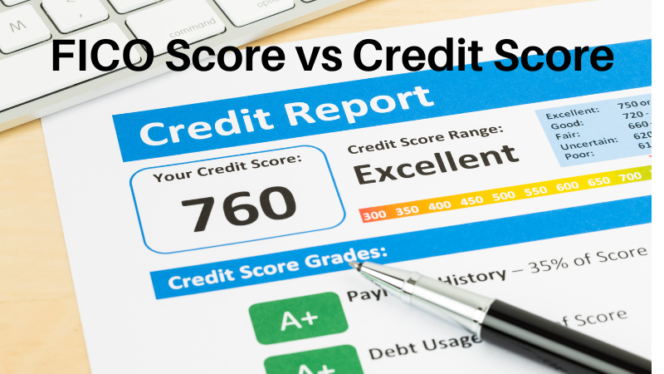FICO Score vs Credit Score: The Differences

So, what is the difference between FICO Score vs Credit Score?
Credit scores typically vary between 300 and the 850 mark, contrary to what many believe it’s not only one score. You may have many credit scores. The most commonly used is the FICO Score.
It’s sometimes difficult to identify the scores that matter the most, how they differ from each other, and how to locate these numbers that play an essential role in our lives as financial people.
Let’s dig deeper into the credit scores.
TABLE OF CONTENTS:
- FICO Score vs Credit Scores: The Differences
- What is a Credit Score?
- What is a FICO Score?
- How Do I Interpret My Fico Score?
- How Credit Scores Are Calculated?
FICO Score vs Credit Scores: The Differences
The lenders make use of the credit score to assess your creditworthiness. Your credit scores may affect your chances of being approved for credit cards, mortgages, and personal loans. Your scores affect what rates of interest you can expect to receive for credit products.
The higher your score, the more appealing you’ll look to lenders. But there’s a flip of the coin. As your score decreases, the chance of receiving approval from lenders will drop.
There are different scores for your credit because lenders provide your credit information in one of three credit bureaus: Equifax, Experian, and TransUnion.
Each bureau may have different details about you on their credit reports. Your credit score will be estimated based on the information contained in a single credit report.
Each report may generate different scores, even if an identical scoring system is employed to determine the score.
Many companies provide different credit score models.
What is a Credit Score?
Credit scores are numbers that summarize the risk you face in your credit by looking at your credit history at a particular moment in time. A credit score can help the lenders assess their credit reports and determine the risk to your credit.
The most commonly used score for credit is FICO Scores. Creditors can purchase it from one of the three credit agencies. They use FICO Scores to make millions of credit decisions each year. FICO creates FICO Scores solely based on the information in consumer credit reports that credit reporting companies keep.
Your credit score affects the amount of credit accessible to you, and the conditions (interest rate, etc.) lenders provide. It is a crucial aspect of your credit score.
This guide will assist you in understanding the process of credit scoring. Understanding your FICO Score can help you manage your credit health. If you know how your credit risk is assessed, you can take action that could lower your credit risk and increase your credit score over time. A higher FICO will mean better financial options for you.
What is a FICO Score?
A FICO score is several three digits calculated from the information about your credit that appears on your credit report from the consumer reporting agency (CRA) at a particular moment. It combines data from the credit file into one number that lenders use to rapidly determine your credit risk consistently, objectively, and fairly.
FICO Scores comprise among the many variables almost all lenders in the U.S. consider when making crucial credit decisions. The key to these decisions is whether or not to approve your credit application, which terms you can get from your credit and whether you should increase your credit limit after the credit account is set up.
Hundreds of creditors use FICO scores, including the biggest lenders, which makes it the most frequently utilized credit score. Experts have estimated that it can be used in 90% of credit decisions. Lenders can look at other factors in making their credit decisions. Other elements lenders could consider:
- Information you provided when you applied for credit.
- The amount you earn.
- The amount you pay for your daily expenses.
- The way you manage your checking, credit, and savings accounts.
Lenders look at your credit report to assess how you’ve handled your credit up to this point. If you are willing to accept credit and handle it with care by paying it on time and per the terms you have agreed to. You prove to the lenders that you are an excellent credit risk.
How Do I Interpret My FICO Score?
A FICO Score can be determined using a mathematical formula that analyzes various types of data from your credit reports when the request is submitted. Comparing the information with the patterns found in millions of previous credit and other reports, a FICO Score gives lenders a consistent and accurate assessment of your future credit risk.
FICO Scores usually are within the 300-850 range. Some lenders employ their own FICO Score, which falls between 150 and 950.
| FICO SCORE | RATING | HOW TO INTERPRET YOUR SCORE |
| Under 580 | Poor | Your score is far below the standard for U.S. consumers and demonstrates to lenders that you’re a risky borrower. |
| 580-669 | Fair | Your score is less than the typical score for U.S. consumers, though most lenders will grant credit with this rating. |
| 670-739 | Good | Your score is just a little higher than the average of U.S. consumers, and most lenders view this as a positive score. |
| 740-799 | Very Good | Your score is in line with the median score of U.S. consumers and demonstrates to the lenders that you’re a reliable borrower. |
| More than 800 | Exceptional | Your score is significantly higher than your average of U.S. consumers, proving to lenders that you’re an outstanding borrower. |
A higher Score means less risk. Conversely, smaller FICO scores indicate greater risk.
Every lender has its own criteria to approve credit applications, such as the level of risk it believes is acceptable for a particular credit product.
The FICO research indicates that people with a higher score tend to:
- Pay every payment on time each month
- Make sure to keep the balances of credit cards low
- Make an application for credit only whenever needed
- Have long credit history
How Credit Scores Are Calculated?
All credit scores include FICO scores and VantageScore, which are credit-related scores calculated using similar credit scoring models. Your credit score is calculated based on your:
- The history of payment
- The amount owed
- The length of credit history
- New credit
- Credit mix (aka credit diversity)
Points are awarded based on the credit information in your credit reports. The main difference between FICO and VantageScore is that both assign different weights to the various categories of credit information.
For example, a person with no late payments may receive 200 points in the FICO scoring model. But can get 180 points using the VantageScore scoring model.
The lenders also interpret FICO in addition to Vantage Score ratings differently. A score of 660 FICO score could suffice to be able to qualify for a credit card from one issuer. In contrast, another lender may require a score of 680 Vantage Score to be able to approve.


